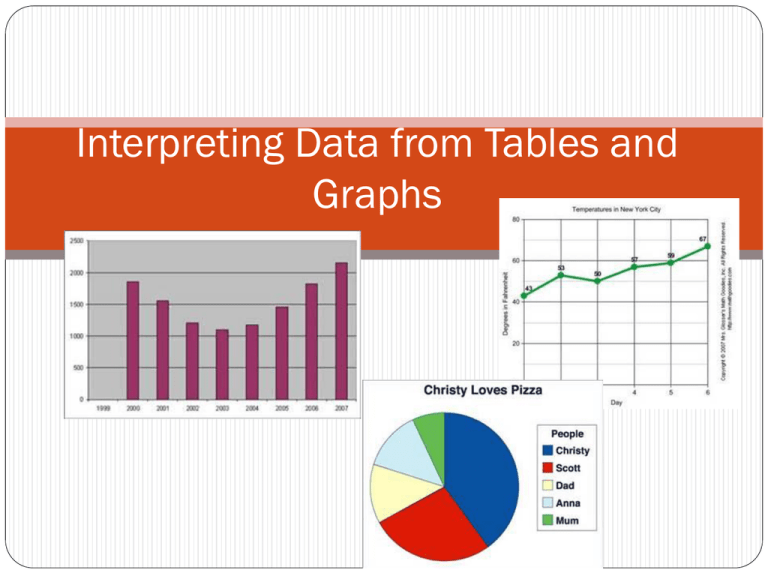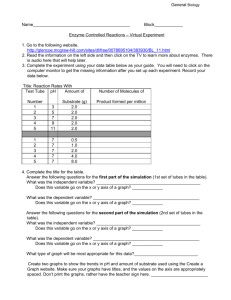Interpreting Data from Tables and Graphs
advertisement

Interpreting Data from Tables and Graphs What are Tables and Graphs Tables and graphs are visual representations. They are used to organize information to show patterns and relationships. A graph shows information by representing it as a shape. Scientists use tables and graphs to record data Not only used in science Importance of Tables and Graphs As a source of evidence, or as a way of exploring patterns and relationships in data or information. The Problem extracting and interpreting information Identifying trends Reading the title Labeling correctly Collect Data First The data comes first Then you organize the data, usually in a table. Then figure out which graph to draw What is a Table? • an organizer for an Good Title investigation • a way of presenting data in a report • independent variables go in the left hand columns • dependent variables on the right. Should be able to see numerical relationships and patterns. A graph may make these clearer. Graphs Are a way of exploring the relationships in data Graphs display the data and are a way to report the data Graphs make it easier to see Patterns, relationships, distributions and trends of the data Main types of Graphs Line Bar Pie Charts Scatter Plot Bar Graphs Comparing two groups or more than two groups Many times the bar will represent an average Bar graphs contain categories Line Graph Used to show change over time Connect the dots with a line Scatter Plot Shows correlation of variables How much one variable is affected by the other Their relationship is a correlation Do not connect the dots Pie Chart Show parts of the whole How to Draw? – Honors ONLY Check out this YouTube video from Bozeman science on Tables and Graphs http://www.mathgoodies.com/lessons/graphs/images/line_example2.jpg https://www.youtube.com/watch?v=9NkT-oYPkOA Reading Graphs Orient yourself with the X and Y axis pH influence on enzyme activity X axis (independent variable) is the strength of pH Y axis (dependent variable) is the percent of the enzyme activity. At the top 100% of the enzyme is at work Look at the intervals or scale of the data Also: Read the title. This will tell you what the graph data is showing Reading Graphs Identify the Trends of the Chart Understand the relationships • Pepsin peaks around pH of 2 • Enzyme “Green” peaks around pH of 6.8 • Enzyme “Blue” peaks around pH of 8 Question? Which enzyme works best at pH 3? You have to start on the X axis go to pH 3, then travel up the Y axis to see which enzyme has the highest percentage. So we would pick? Enzyme Pepsin (red) Question? What is the optimum pH for enzyme Trypsin? Now you have to start on the Y axis and go to the highest peak on Trypsin, then follow this down to the X axis. The answer is? pH 8 Questions: Try to answer the question on your own before looking at any choices. That way you won’t be swayed to change your answer, or become confused. Question: What is the order of enzyme activity from greatest to least at pH 6? A. B. C. D. Green, Red , Blue Blue, Red, Green Red, Blue, Green Green, Blue, Red What does this chart tell us? Look at the arrow, what is the overall trend? What do you think these arrows represent in the data? Question? Number of families is along the Y axis. So go to the Y axis and go across to the highest point on the graph. That leads you to the Tertiary Period. At which point did the largest extinction occur? See next slide Look at each extinction point. This one has the largest dip. A. Is the correct answer. End of Permian Period This link takes you to a YouTube version of these examples https://www.youtube.com/watch?v=HSvKkXkjJ9I Answer the following Bar Graph Bar graphs are usually easier to read. Make sure you look at each axis and the labels. A question for this graph might be: Which month had the lowest recorded temperature in 2004? Tables usually pretty easy to read Which pH produced the most average plant growth? What is the range of pH producing the optimum growth for plants?






